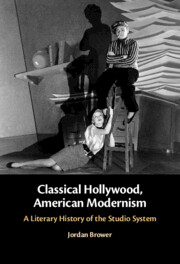Book contents
- Classical Hollywood, American Modernism
- Classical Hollywood, American Modernism
- Copyright page
- Dedication
- Contents
- Figures
- Acknowledgments
- Introduction
- Chapter 1 Paramount Pictures and Transmedial Possibility
- Chapter 2 MGM Modernism
- Chapter 3 The Motion Picture Industry’s Coming of Age
- Chapter 4 Global Hollywood
- Chapter 5 The Scenes of an Ending
- Chapter 6 Conclusion
- Notes
- Index
Chapter 3 - The Motion Picture Industry’s Coming of Age
Published online by Cambridge University Press: 04 January 2024
- Classical Hollywood, American Modernism
- Classical Hollywood, American Modernism
- Copyright page
- Dedication
- Contents
- Figures
- Acknowledgments
- Introduction
- Chapter 1 Paramount Pictures and Transmedial Possibility
- Chapter 2 MGM Modernism
- Chapter 3 The Motion Picture Industry’s Coming of Age
- Chapter 4 Global Hollywood
- Chapter 5 The Scenes of an Ending
- Chapter 6 Conclusion
- Notes
- Index
Summary
In the late 1930s, the studio system and its ancillary institutions (museums, newspapers, and trade journals) engaged in a concerted effort to narrate the industry’s maturation. This tendency manifested onscreen in the emergence of the historiographical backstudio picture, led by David Selznick’s A Star is Born (1937) and followed by Warners’ Boy Meets Girl (1938) and Fox’s Hollywood Cavalcade (1939). The belief in Hollywood’s coming-of-age gave rise to a countervailing sense that the Hollywood novel had become exhausted. Writers as different as Cedric Belfrage (Promised Land, 1938), Horace McCoy (I Should Have Stayed Home, 1938), and Patsy Ruth Miller (That Flannigan Girl, 1939), among others, used this heightened historical sense to renovate the genre. No renovator was more successful or less understood than Nathanael West. In The Day of the Locust (1939), West contributed to American modernist inscrutability in his occult bildungsroman of painter Tod Hackett. West dared readers to see Tod’s monstrous coming of age alongside the studio system’s own in Tod’s submissions to the order of Hollywood’s aesthetics and the law of the police that rescue him in the novel’s concluding riot.
Keywords
- Type
- Chapter
- Information
- Classical Hollywood, American ModernismA Literary History of the Studio System, pp. 84 - 112Publisher: Cambridge University PressPrint publication year: 2024



